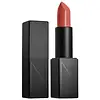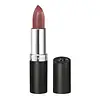What's inside
What's inside
 Key Ingredients
Key Ingredients

 Benefits
Benefits

 Concerns
Concerns

 Ingredients Side-by-side
Ingredients Side-by-side

Ricinus Communis Seed Oil
MaskingBis-Diglyceryl Polyacyladipate-2
EmollientEthylhexyl Palmitate
EmollientCandelilla Cera
EmollientEuphorbia Cerifera Wax
Isononyl Isononanoate
EmollientOzokerite
Emulsion StabilisingButyrospermum Parkii Butter
Skin ConditioningCetearyl Alcohol
EmollientHydrogenated Polycyclopentadiene
Cera Microcristallina
Emulsion StabilisingIsopropyl Myristate
EmollientSilica
AbrasiveCetearyl Ethylhexanoate
EmollientCeteareth-20
CleansingPropylene Carbonate
SolventPolyhydroxystearic Acid
EmulsifyingIsopropyl Titanium Triisostearate
EmollientStearalkonium Hectorite
Gel FormingPolyethylene
AbrasiveCaprylyl Glycol
EmollientCopernicia Cerifera Wax
Phenoxyethanol
PreservativeCoprinus Comatus Extract
AntioxidantLecithin
EmollientCalophyllum Inophyllum Seed Oil
AntimicrobialSimethicone
EmollientTocopheryl Acetate
AntioxidantSorbitan Isostearate
EmulsifyingDextrin
AbsorbentWater
Skin ConditioningHexylene Glycol
EmulsifyingHydrogenated Phosphatidylcholine
EmulsifyingLysolecithin
EmulsifyingPortulaca Pilosa Extract
Skin ConditioningTocopherol
AntioxidantSucrose Cocoate
EmulsifyingAscorbyl Palmitate
AntioxidantPalmitoyl Tripeptide-38
Skin ConditioningDisodium EDTA
Mica
Cosmetic ColorantCI 77891
Cosmetic ColorantCI 77491
Cosmetic ColorantCI 77492
Cosmetic ColorantCI 77499
Cosmetic ColorantCI 45410
Cosmetic ColorantCI 15850
Cosmetic ColorantCI 19140
Cosmetic ColorantRicinus Communis Seed Oil, Bis-Diglyceryl Polyacyladipate-2, Ethylhexyl Palmitate, Candelilla Cera, Euphorbia Cerifera Wax, Isononyl Isononanoate, Ozokerite, Butyrospermum Parkii Butter, Cetearyl Alcohol, Hydrogenated Polycyclopentadiene, Cera Microcristallina, Isopropyl Myristate, Silica, Cetearyl Ethylhexanoate, Ceteareth-20, Propylene Carbonate, Polyhydroxystearic Acid, Isopropyl Titanium Triisostearate, Stearalkonium Hectorite, Polyethylene, Caprylyl Glycol, Copernicia Cerifera Wax, Phenoxyethanol, Coprinus Comatus Extract, Lecithin, Calophyllum Inophyllum Seed Oil, Simethicone, Tocopheryl Acetate, Sorbitan Isostearate, Dextrin, Water, Hexylene Glycol, Hydrogenated Phosphatidylcholine, Lysolecithin, Portulaca Pilosa Extract, Tocopherol, Sucrose Cocoate, Ascorbyl Palmitate, Palmitoyl Tripeptide-38, Disodium EDTA, Mica, CI 77891, CI 77491, CI 77492, CI 77499, CI 45410, CI 15850, CI 19140
Ricinus Communis Seed Oil
MaskingCandelilla Cera
EmollientOctyldodecanol
EmollientCaprylic/Capric Triglyceride
MaskingMyristyl Lactate
EmollientVp/Hexadecene Copolymer
Castor Oil/Ipdi Copolymer
Lanolin
EmollientParaffin
PerfumingMeadowfoam Estolide
Skin ConditioningMyristyl Myristate
EmollientCera Microcristallina
Emulsion StabilisingSilica
AbrasiveParfum
MaskingSynthetic Fluorphlogopite
Calcium Aluminum Borosilicate
Benzyl Benzoate
AntimicrobialCalcium Sodium Borosilicate
Dipentaerythrityl Hexa C5-9 Acid Esters
Skin ConditioningDi-PPG-3 Myristyl Ether Adipate
EmollientSorbitan Sesquioleate
EmulsifyingTocopherol
AntioxidantCopernicia Cerifera Cera
EmollientPropylparaben
PreservativeAscorbyl Palmitate
AntioxidantBenzyl Salicylate
PerfumingBenzyl Cinnamate
PerfumingLinalool
PerfumingChamomilla Recutita Flower Extract
MaskingCucumis Sativus Fruit Extract
EmollientCinnamyl Alcohol
PerfumingTin Oxide
AbrasiveEugenol
PerfumingPentaerythrityl Tetra-Di-T-Butyl Hydroxyhydrocinnamate
AntioxidantMica
Cosmetic ColorantCI 77891
Cosmetic ColorantCI 19140
Cosmetic ColorantIron Oxides
CI 15850
Cosmetic ColorantCI 45410
Cosmetic ColorantCI 15985
Cosmetic ColorantCI 75470
Cosmetic ColorantCI 17200
Cosmetic ColorantCI 42090
Cosmetic ColorantRicinus Communis Seed Oil, Candelilla Cera, Octyldodecanol, Caprylic/Capric Triglyceride, Myristyl Lactate, Vp/Hexadecene Copolymer, Castor Oil/Ipdi Copolymer, Lanolin, Paraffin, Meadowfoam Estolide, Myristyl Myristate, Cera Microcristallina, Silica, Parfum, Synthetic Fluorphlogopite, Calcium Aluminum Borosilicate, Benzyl Benzoate, Calcium Sodium Borosilicate, Dipentaerythrityl Hexa C5-9 Acid Esters, Di-PPG-3 Myristyl Ether Adipate, Sorbitan Sesquioleate, Tocopherol, Copernicia Cerifera Cera, Propylparaben, Ascorbyl Palmitate, Benzyl Salicylate, Benzyl Cinnamate, Linalool, Chamomilla Recutita Flower Extract, Cucumis Sativus Fruit Extract, Cinnamyl Alcohol, Tin Oxide, Eugenol, Pentaerythrityl Tetra-Di-T-Butyl Hydroxyhydrocinnamate, Mica, CI 77891, CI 19140, Iron Oxides, CI 15850, CI 45410, CI 15985, CI 75470, CI 17200, CI 42090
 Reviews
Reviews

Ingredients Explained
These ingredients are found in both products.
Ingredients higher up in an ingredient list are typically present in a larger amount.
Ascorbyl Palmitate is created by combining pure Vitamin C and palmitic acid. It is an antioxidant and helps reduce hyperpigmentation.
This ingredient is a more stable version of Vitamin C, meaning it does not disintegrate as quickly when exposed to sunlight. However, studies show it does not penetrate skin as well as pure Vitamin C.
Ascorbyl Palmitate is oil soluble.
Read more about other types of Vitamin C:
Learn more about Ascorbyl PalmitateCandelilla Cera isn't fungal acne safe.
Cera Microcristallina isn't fungal acne safe.
Ci 15850 is the pigment color red. It is an azo dye and created synthetically.
Azo dyes need to be thoroughly purified before use. This allows them to be more stable and longer-lasting.
This ingredient is common in foundations, lipsticks, and blushes. This color is described as brown/orangey red.
It has many secondary names such as Red 6 and Red 7. According to a manufacturer, Red 6 usually contains aluminum.
Learn more about CI 15850CI 19140 is also known as Tartrazine. Tartrazine is a synthetic dye used in cosmetics, foods, and medicine to add a yellow color.
Tartrazine is created from petroleum and is water-soluble.
Some people may experience allergies from this dye, especially asthmatics and those with an aspirin intolerance.
Learn more about CI 19140CI 45410 is a synthetic red-pigment and dye.
It often goes by both Red 28 or Red 27; manufacturers label both ingredients as CI 45410.
This dye is commonly found in makeup because it imparts a vivid color. Some types of this dye change color based on pH level and interaction with moisture:
Your skin has a natural pH of around 4.5 - 5.5.
According to the FDA, CI 45410 is not permitted for use in eye products.
Red 27 is a flourescein dye and commonly used as a fluorescent tracer in medicine.
Learn more about CI 45410Ci 77891 is a white pigment from Titanium dioxide. It is naturally found in minerals such as rutile and ilmenite.
It's main function is to add a white color to cosmetics. It can also be mixed with other colors to create different shades.
Ci 77891 is commonly found in sunscreens due to its ability to block UV rays.
Learn more about CI 77891Mica is a naturally occurring mineral used to add shimmer and color in cosmetics. It can also help improve the texture of a product or give it an opaque, white/silver color.
Serecite is the name for very fine but ragged grains of mica.
This ingredient is often coated with metal oxides like titanium dioxide. Trace amounts of heavy metals may be found in mica, but these metals are not harmful in our personal products.
Mica has been used since prehistoric times throughout the world. Ancient Egyptian, Indian, Greek, Roman, Aztec, and Chinese civilizations have used mica.
Learn more about MicaRicinus Communis Seed Oil is the INCI name for castor oil.
Castor Oil helps moisturize the skin. It is rich in a fatty acid called ricinoleic acid. This fatty acid helps prevent moisture loss on the skin. This helps keep your skin soft and hydrated. Ricinoleic acid also has anti-inflammatory and pain reducing properties.
Besides hydrating the skin, castor oil is also used to hydrate hair. By keeping the hair shaft moisturized, breakage is decreased. More studies are needed to show castor oil's effective on stimulating hair growth.
Castor oil is created by cold-pressing castor seeds and then purifying the oil with heat. It was used in Ancient Egypt as fuel in lamps and to help treat eye irritation.
The term 'fragrance' is not regulated in many countries. In many cases, it is up to the brand to define this term. For instance, many brands choose to label themselves as "fragrance-free" because they are not using synthetic fragrances. However, their products may still contain ingredients such as essential oils that are considered a fragrance.
Learn more about Ricinus Communis Seed OilSilica, also known as silicon dioxide, is a naturally occurring mineral. It is used as a fine, spherical, and porous powder in cosmetics.
Though it has exfoliant properties, the function of silica varies depending on the product.
The unique structure of silica enhances the spreadability and adds smoothness, making it a great texture enhancer.
It is also used as an active carrier, emulsifier, and mattifier due to its ability to absorb excess oil.
In some products, tiny microneedles called spicules are made from silica or hydrolyzed sponge. When you rub them in, they lightly polish away dead skin layers and enhance the penetration of active ingredients.
Learn more about SilicaTocopherol (also known as Vitamin E) is a common antioxidant used to help protect the skin from free-radicals and strengthen the skin barrier. It's also fat soluble - this means our skin is great at absorbing it.
Vitamin E also helps keep your natural skin lipids healthy. Your lipid skin barrier naturally consists of lipids, ceramides, and fatty acids. Vitamin E offers extra protection for your skin’s lipid barrier, keeping your skin healthy and nourished.
Another benefit is a bit of UV protection. Vitamin E helps reduce the damage caused by UVB rays. (It should not replace your sunscreen). Combining it with Vitamin C can decrease sunburned cells and hyperpigmentation after UV exposure.
You might have noticed Vitamin E + C often paired together. This is because it is great at stabilizing Vitamin C. Using the two together helps increase the effectiveness of both ingredients.
There are often claims that Vitamin E can reduce/prevent scarring, but these claims haven't been confirmed by scientific research.
Learn more about Tocopherol